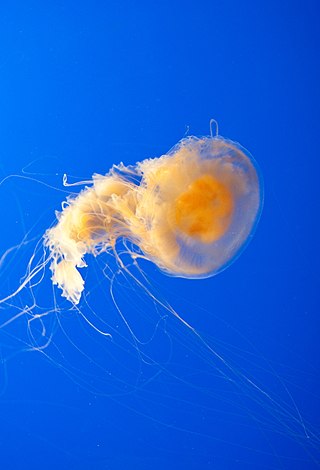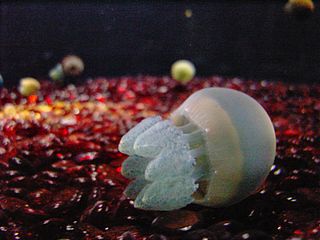
Cnidaria is a phylum under kingdom Animalia containing over 11,000 species of aquatic animals found both in fresh water and marine environments, including jellyfish, hydroids, sea anemones, corals and some of the smallest marine parasites. Their distinguishing features are a decentralized nervous system distributed throughout a gelatinous body and the presence of cnidocytes or cnidoblasts, specialized cells with ejectable flagella used mainly for envenomation and capturing prey. Their bodies consist of mesoglea, a non-living, jelly-like substance, sandwiched between two layers of epithelium that are mostly one cell thick. Cnidarians are also some of the only animals that can reproduce both sexually and asexually.

Jellyfish, also known as sea jellies, are the medusa-phase of certain gelatinous members of the subphylum Medusozoa, which is a major part of the phylum Cnidaria.

The Scyphozoa are an exclusively marine class of the phylum Cnidaria, referred to as the true jellyfish.

Aurelia aurita is a species of the family Ulmaridae. All species in the genus are very similar, and it is difficult to identify Aurelia medusae without genetic sampling; most of what follows applies equally to all species of the genus.

The Atlantic sea nettle, also called the East Coast sea nettle in the United States, is a species of jellyfish that inhabits the Atlantic coast of the United States. Historically it was confused with several Chrysaora species, resulting in incorrect reports of C. quinquecirrha from other parts of the Atlantic and other oceans. Most recently, C. chesapeakei of estuaries on the Atlantic coast of the United States, as well as the Gulf of Mexico, was only fully recognized as separate from C. quinquecirrha in 2017. It is smaller than the Pacific sea nettle, and has more variable coloration, but is typically pale, pinkish or yellowish, often with radiating more deeply colored stripes on the exumbrella, especially near the margin.

Aequorea victoria, also sometimes called the crystal jelly, is a bioluminescent hydrozoan jellyfish, or hydromedusa, that is found off the west coast of North America.

Jellyfish Lake is a marine lake located on Eil Malk island in Palau. Eil Malk is part of the Rock Islands, a group of small, rocky, mostly uninhabited islands in Palau's Southern Lagoon, between Koror and Peleliu. There are about 70 other marine lakes located throughout the Rock Islands. Millions of golden jellyfish migrate horizontally across the lake daily.

Pelagia noctiluca is a jellyfish in the family Pelagiidae and the only currently recognized species in the genus Pelagia. It is typically known in English as the mauve stinger, but other common names are purple-striped jelly, purple stinger, purple people eater, purple jellyfish, luminous jellyfish and night-light jellyfish. In Greek, pelagia means "(she) of the sea", from pelagos "sea, open sea"; in Latin noctiluca is the combining form of nox, "night"", and lux, "light"; thus, Pelagia noctiluca can be described as a marine organism with the ability to glow in the dark (bioluminescence). It is found worldwide in tropical and warm temperate seas, although it is suspected that records outside the North Atlantic region, which includes the Mediterranean and Gulf of Mexico, represent closely related but currently unrecognized species.

Phacellophora camtschatica, commonly known as the fried egg jellyfish or egg-yolk jellyfish, is a very large jellyfish in the family Phacellophoridae. This species can be easily identified by the yellow coloration in the center of its body which closely resembles an egg yolk, hence its common name. Some individuals can have a bell close to 60 cm (2 ft) in diameter, and most individuals have 16 clusters of up to a few dozen tentacles, each up to 6 m (20 ft) long. A smaller jellyfish, Cotylorhiza tuberculata, typically found in warmer water, particularly in the Mediterranean Sea, is also popularly called a fried egg jellyfish. Also, P. camtschatica is sometimes confused with the Lion's mane jellyfish.

Phyllorhiza punctata is a species of jellyfish, also known as the floating bell, Australian spotted jellyfish, brown jellyfish or the white-spotted jellyfish. It is native to the western Pacific from Australia to Japan, but has been introduced widely elsewhere. It feeds primarily on zooplankton. P. punctata generally can reach up to 50 centimetres (20 in) in bell diameter, but in October 2007, one 74 cm (29 in) wide, perhaps the largest ever recorded, was found on Sunset Beach, North Carolina.

Cotylorhiza is a genus of true jellyfish from the family Cepheidae. The genus is found in the central-east Atlantic, Mediterranean, and western Indian Ocean.

Aurelia is a genus of jellyfish that are commonly called moon jellies, which are in the class Scyphozoa. There are currently 25 accepted species and many that are still not formally described.

Cyanea is a genus of jellyfish, primarily found in northern waters of the Atlantic and Pacific Oceans and southern Pacific waters of Australia and New Zealand, there are also several boreal, polar, tropical and sub-tropical species. Commonly found in and associated with rivers and fjords. The same genus name has been given to a genus of plants of the Hawaiian lobelioids, an example of a parahomonym.

Catostylidae is a family of jellyfish, their common name is fat-armed jellies. Members of this family are characterized by their thick, sausage-like oral arms. Members of the family Catostylidae are small marine jellyfish with domed bells. The eight short oral arms are broad and three-sided. These jellies do sting but usually only leave minor burns.

The helmet jellyfish, sometimes called the merchant-cap, is a luminescent, red-colored jellyfish of the deep sea, belonging to the order Coronatae of the phylum Cnidaria. It is the only species in the monotypic genus Periphylla and is one of the rare examples in Scyphozoa which life-cycle lacks a polyp stage. This species is photophobic and inhabits deeper parts of the oceans to avoid light. It may be found at the surface on dark nights.

Rhopilema verrilli, or mushroom cap jellyfish, is a species of jellyfish in the family Rhizostomatidae. They are cnidarian invertebrates distinguished by their mushroom-shaped medusae. The species does not have any tentacles; however, they still have stinging cells, called nematocysts, within their bells, which can produce mild stings to humans.

The South American sea nettle is a species of jellyfish from the family Pelagiidae. It is found from the Pacific coast of Peru, south along Chile's coast to Tierra del Fuego, and north along the Atlantic coast of Argentina, with a few records from Uruguay. Despite its common name, it is not the only sea nettle in South America. For example, C. lactea is another type of sea nettle in this region. Historically, C. plocamia was often confused with C. hysoscella, a species now known to be restricted to the northeast Atlantic. C. plocamia is a large jellyfish, up to 1 m in bell diameter, although most mature individuals only are 25–40 cm (10–16 in).

Versuriga is a monotypic genus of jellyfishes belonging to the monotypic family Versurigidae. The only species is Versuriga anadyomene. This species is rare, only having been sighted in a limited region. However, it can be identified by its gradient-like coloration, as well as its umbrella shaped bell, which is common amongst other members of the class Scyphozoa. This species is important for many reasons, ranging from ecological interactions to socioeconomic benefits. Notably, Versuriga is able to form commensalistic relationships with other organisms, impacting biodiversity, as well as being a food source for humans and other predators.

Crambionella is a genus of Cnidarians belonging to the family Catostylidae. The genus is distinguishable from other Castostylid species by a terminal club on each oral arm without filaments and a canal system featuring a narrow, wide-meshed intra-circular network of interconnected vessels. These vessels solely communicate with the ring canal and not with the radial canals. Four species belong to the genus Crambionella : C. annandalei, C. helmbiru, C. orsini and C. stuhlmanni. C. orsini is the type species for the genus.

Aurelia coerulea or Asian moon jelly is a species of moon jelly in the genus Aurelia. This species is native to the seas off Japan, China, Korea, and California, as well as the Mediterranean and other temperate seas. and they can also be found in coastal areas of China, Korea, California, the Mediterranean and other temperate seas. It is particularly abundant in artificial habitats and sheltered regions. It has a very high reproductive rate which can cause blooming events. A.coerulea blooming causes problems such as impairing fisheries, clogging the nuclear power plants and disrupting the local zooplankton abundance. The chemical compounds the species secretes as a self-defense mechanism can be used for pharmaceutical purposes.
























